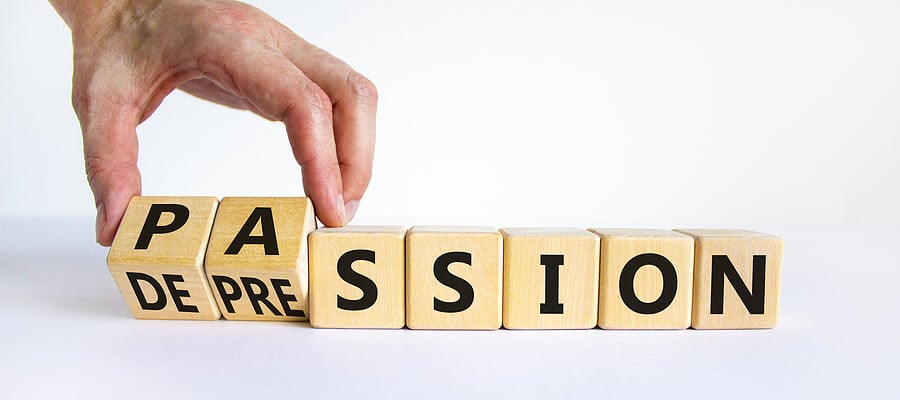Table of Contents
 What is dopamine deficiency?
What is dopamine deficiency?
Low dopamine levels feel like this. You know those days when you feel like you’re dragging your feet, fatigued, mood swings, lack of motivation, and can’t remember a thing?
You may be low in dopamine.
Dopamine is your main neurotransmitter for motivation, feeling productive, focus, and learning and memory.
It’s your zest for life.[i]
If you feel like you’re missing out on life, low dopamine may be the reason.
The good news is, once you are aware of it, you can easily boost dopamine levels in your brain. Which I’ll share with you in a minute.
 But are you sure it’s Dopamine?
But are you sure it’s Dopamine?
Here’s a crazy little statistic. Less than 1 percent of your brain’s neurons are dopamine neurons.[ii]
And yet it seems everybody is talking about dopamine. It’s even a popular research topic in the neuroscience community.
But what people often blame on dopamine, it could be something else entirely that is going wrong in your brain.[iii]
Now, assuming you got it right, dopamine is one of three catecholamine neurotransmitters.
With the help of various enzymes and cofactors, dopamine also contributes to the production of norepinephrine and epinephrine (adrenaline).
Dopamine is linked to feelings of pleasure and euphoria. It’s also critical for appetite, reward processing, libido, short-term memory, creativity, attention, body movement, and motivation.[iv]
Epinephrine and norepinephrine act to increase alertness and attention.[v]
 What it feels like to be deficient in dopamine
What it feels like to be deficient in dopamine
If you are low in dopamine, everything is dull.
And you will have very little enthusiasm for life.
You find yourself reaching for caffeine, sugar, or stimulants because it’s the only way you can get through your day.
Dopamine deficiency symptoms include apathy, fatigue, feeling hopeless, can’t complete tasks, can’t concentrate, or can’t connect with others.
You can’t feel pleasure. No motivation, poor libido, memory loss, mood swings, procrastination, insomnia, and possibly addictions.
If any of this rings true for you, consider using a nootropic supplement to increase dopamine levels in your brain.
Best nootropics to increase dopamine
You can increase dopamine levels in your brain with the amino acids L-Phenylalanine or L-Tyrosine which is present in a variety of foods.
You can also increase dopamine by using L-DOPA (from Mucuna Pruriens) but I don’t recommend it. Not at the start. Because L-DOPA immediately makes dopamine.
There is no wiggle room. And if you don’t get the dosage right you’ll soon know what happens when dopamine is high.
You also miss out on making thyroid hormone. Because L-Tyrosine works with iodine and some other cofactors for the production of thyroid hormones. L-DOPA does not do that.
You can also get L-Tyrosine and L-Phenylalanine from high-protein foods such as poultry, fish, dairy, nuts, soy products, lima beans, avocados, and bananas.
But you may be low in dopamine because you suffer from one of 18 known disorders of tyrosine metabolism.[vi]
Or you don’t eat enough food containing these amino acids.
You could also be missing one or more of the cofactors or enzymes needed to convert L-Phenylalanine and/or L-Tyrosine into dopamine.
Whatever the reason. If you suspect you are low in dopamine, the easiest and quickest way to boost levels of these critical neurotransmitters is to use a nootropic supplement.
L-Tyrosine recommended dosage for increasing dopamine is 500 mg – 2 or 3-times per day.
You may find your body responds better to smaller doses. Or you may need to double your dose if you’re stacking it with ADHD stimulant meds. Listen to your body and see how you react.
Or you can try N-Acetyl L-Tyrosine (NALT) which is simply L-Tyrosine with an acetyl group added. Which breaks down in your kidneys back into L-Tyrosine.
NALT is a more soluble form of L-Tyrosine so it should be more bioavailable to your brain. But some studies say this isn’t so.[vii]
I’ve tried both and use whichever one I have on hand. I find they both L-Tyrosine and NALT are equally as effective for me. Try each for a month and see which one works better for you.
 You can also get N-Acetyl L-Tyrosine in what many believe to be the best pre-formulated nootropic stack on the planet (over 1 million bottles sold), and my favorite pre-made nootropic stack – Mind Lab Pro®.
You can also get N-Acetyl L-Tyrosine in what many believe to be the best pre-formulated nootropic stack on the planet (over 1 million bottles sold), and my favorite pre-made nootropic stack – Mind Lab Pro®.
Mind Lab Pro® is considered a “universal” nootropic because it can stand on its own. And is effective with just 2-capsules per day.
Because Mind Lab Pro® also contains Citicoline, Bacopa Monnieri (24% bacosides), organic Lion’s Mane Mushroom (full spectrum including the fruiting body and mycelium), Phosphatidylserine (from sunflower lecithin), L-Theanine, Rhodiola Rosea (3% rosavins, 1% salidrosides), Maritime Pine Bark Extract (95% proanthocyanidins), and Vitamins B6, B9 and B12 (as NutriGenesis®).
Get: Mind Lab Pro®
Get: Performance Lab NutriGenesis® Multi
Conclusion
If you feel like you’re dragging your feet more days than not. Mood swings make life unpleasant for those around you.
If your get up and go feels like it has got up and gone. You have no motivation and cannot remember a thing.
You may be dopamine deficient. And the easiest way to know for sure is to try supplementing with L-Tyrosine 500 mg twice per day for 2 or 3 days.
See if L-Tyrosine or NALT makes a difference. If you feel a positive change then you know for sure you were dopamine deficient. And now you know how to fix a dopamine deficiency and start enjoying life once again.






Join The Discussion - 12 comments
Karen Warren
December 26, 2024
Hi David, I was getting along very well for over a year taking l-tyrosine. I have recently read that certain amino acids including tyrosine can induce and/or feed cancer. Now, I am very nervous about taking it. Have you heard this?
David Tomen
December 30, 2024
Karen, do not believe everything you read on the internet. You get Tyrosine when you eat meat. Think about this for a minute. If what you said was true then everyone would get cancer.
Nitin
January 6, 2024
Hello Sir, how to start dopamine system again after prolonged illness.
David Tomen
January 9, 2024
Nitin, the safest long-term solution for increasing dopamine is 500 mg L-Tyrosine 2 or 3-times per day with a BioActive B-Complex and 400 mg magnesium chelate.
Freddy
June 4, 2023
Hello David, I admire you and I always share your work on YouTube and on this website. On this occasion I come to you hopeless for help, without obligation. I did some blood tests and my kidney azotemia values are very high 45.8 mg/dl, my daily Nootropic Stack is: Nalt (400 Mg) – Ginseng (300 mg ) – Quercetyn (500 mg) – Epicor (500 mg) – Sabroxy (100 mg) – Perfonmance Lab Multi – DHA (1000 mg) – Magnesium Glycinate (400 mg) – Bacopa (500 mg). Please, David, could you tell me if any of those nootropics could be causing kidney damage?
And finally,
What nootropic do you recommend to heal my kidneys?
David Tomen
June 5, 2023
Freddy I am not a doctor. And my area of expertise are natural nootropic supplements for the brain and how they can help the human brain. This comes through personal experience and from reading thousands of clinical studies.
I can only suggest you get professional help and take care of the Azotemia you are dealing with because as I’m sure you know that if left unchecked can result in kidney failure.
Many of the supplements we use pass through our kidneys while getting into our body. This will put even further stress on your kidneys. Water soluble supplements including vitamins and minerals are the easiest on your kidneys. I suggest you Google “best supplements for kidney health” and see what turns up. You’ll find a high quality multivitamin like you are already using is recommended. Also, make sure your Vitamin D levels are optimal (https://www.ncbi.nlm.nih.gov/pmc/articles/PMC4889119/).
Others include R-Lipoic Acid, NAC, and Resveratrol. I also suggest you read Life Extension’s article on this subject here; https://www.lifeextension.com/magazine/2010/5/innovative-strategies-to-combat-kidney-disease
Ed
May 15, 2023
What regulates emotion, serotonin or dopamine? Can you use L-Tyrosine or NALT when you a use an antidepressant?
Ed
David Tomen
May 16, 2023
Ed, depending on your definition of “emotion”, it is dependent on any of the major neurotransmitters, oxidative stress, low hormones, poor blood flow, and more. There is no easy solution to countering something like depression because there can be so many different causes.
As for L-Tyrosine, it depends on the antidepressant. If the drug affects dopamine or norepinephrine then it is not a good idea to use L-Tyrosine.
Sparsh
May 8, 2023
Are there alternatives to wellbutrin in nootripic world?
David Tomen
May 8, 2023
There is no direct alternative to Wellbutrin. But some supplements like Saffron and Pine Bark Extract have been compared to Ritalin and were effective.
It depends on what you are trying to do. If it’s to treat the symptoms of ADHD or ADD I’ve done it with a nootropic stack.
Sparsh
May 8, 2023
I have never taken prescription meds before, but my therapist thinks I should take Wellbutrin so I don’t sway too far away from my baseline. The idea is that it may help with self-esteem and drive by working on my dopamine. I wonder if I should do dopamine detox, cold shower or take NALT in place of wellbutrin. I am always apprehensive of taking prescription meds and feel like it should be the absolute last resort. Do you have any suggestions?
I take Ashwagandha KSM 66 daily.
David Tomen
May 11, 2023
Sparsh, L-Tyrosine or NALT (whichever works best for you) boosts dopamine and norepinephrine. Try 500 mg of either twice per day and see how that works for you. You also need a good BioActive B-Complex because Vitamins V6, B9 & B12 are cofactors in the synthesis of dopamine.